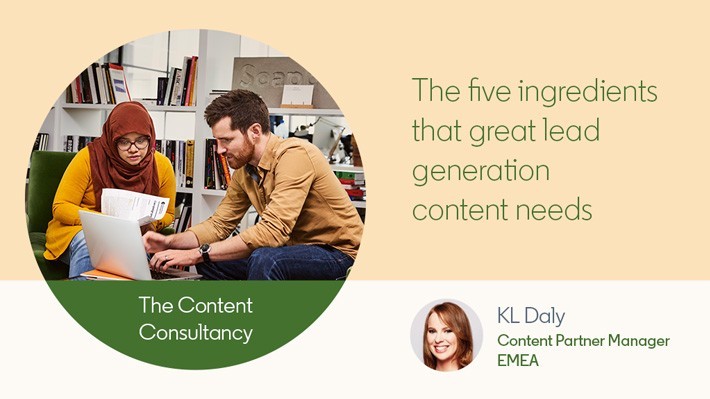The five ingredients that great lead generation content needs
There are many different levers marketers can pull when they’re optimising a lead generation campaign. Have they got the right targeting approach? Are their bids competitive enough? Do they need to go broad and chase volume or narrow down their campaign and chase quality? However, when it comes to ratcheting up the effectiveness of lead generation marketing it’s amazing how often the most important factor of all is overlooked.
To drive great results with a lead generation campaign you need the right content assets – and you need to signal the value of those assets in the right way.
It’s stunningly simple and staggeringly obvious given that your content asset is what you’re offering an audience in exchange for their content details. It provides the entire motivation for potential prospects to stick their hand up as Marketing Qualified Leads (MQLs). And yet it’s often the last thing that marketers look at when asking themselves how they can grow their lead volume – or improve their lead quality.
As LinkedIn’s Content Partner Manager for EMEA and LATAM, a big part of my role is working with advertising customers to explore where adjusting content assets can make a difference for them. I work with LinkedIn’s portfolio of content partners, agencies that specialise in different aspects of content creation and whose services clients can use as part of a campaign booking on our platform. On many occasions, we’ve worked with clients who’ve spent time adjusting their targeting or bids to improve lead volume, quality or cost per lead (CPL) but have never got around to asking whether their content is suited to the lead generation task they’re giving it. It’s amazing what a difference optimising content for lead generation can make.
In my experience, there are five essential ingredients for a top-performing lead generation content asset. When you’re building your campaign, it’s worth sense-checking that your content delivers on these different elements – and making any adjustments that you need to before you start putting budget behind it. And when you’re creating Sponsored Content copy to promote your lead generation assets, aim to signal these different selling points in the headlines, visuals and body copy that you use. Get all five into the mix and you’ll ensure that your lead generation content rises to the task you set it.
Ingredient 1: Relevance and urgency
For a lead generation campaign, effectiveness depends on persuading somebody to click a link and consume a piece of content. That requires a sense of urgency – a reason to take action, there and then. And the best way to achieve that is to align your content asset with the topics that you know your target audience is focusing on at the time.
This could be a case of planning lead generation content that intersects with key moments in your target audience’s calendar. If you’re a cybersecurity business targeting retailers for example, then you know that the issues you help them address will feel more pressing around occasions like Black Friday or Valentine’s Day. Creating content for these moments delivers on relevance and builds the sense of urgency that you need. More generally, you can use tools like the Content Suggestions feature in LinkedIn Pages to analyse the content themes dominating your target audience’s attention – and develop content assets to address them.
Dialling up relevance doesn’t have to involve creating bespoke lead generation content from scratch. You may have an existing content asset that includes insights or advice that have real current value to your target audience, but which aren’t the main focus of the piece. Don’t be afraid to pull out this content and repackage it, emphasising its currency in your Sponsored Content headline and copy. If your content asset has different insights to offer different segments of your target audience, then try creating different Sponsored Content campaigns that call out those specific groups in the headlines. It all helps to emphasise relevance – and provide a compelling reason to click. Don’t be afraid to edit your content campaigns for different audiences.
Ingredient 2: Depth
Lead generation involves a clear value exchange – and failing to deliver on your half of the exchange can have a damaging effect on the quality of leads that you generate. An effective lead generation content asset delivers tangible value that’s worth sharing details for. If you’ve identified a need or an interest on the part of your audience and persuaded them that you’ve got the expertise that they need, then your content has to deliver on these expectations.
Case studies, opinion pieces, entertaining pieces of video content, or short infographics are all extremely valuable forms of content that have powerful roles to play in your marketing strategy. However, they rarely make for effective lead generation content assets because they don’t have the depth of insights that a prospect expects when they fill in a lead gen form. The weight of content that you build a lead gen campaign around has to justify the bargain that’s involved in somebody becoming a lead. If you disappoint them and leave them feeling short-changed, then you’re undermining the opportunity before you even hand it to your sales team.
If you’re concerned that your content asset is too light to play a lead generation role then don’t give up – but don’t press on regardless either. Explore opportunities for bolstering the value that you’re offering. If your content asset is a case study, are there other client testimonials that you could pull together into a compendium illustrating different solutions to the problems that your prospects face? If you have an opinion piece from a member of your C-suite, can you reach out to other experts in your business for their perspective? Or use this as the foundation for content that sets out action plans and recommendations for prospects to follow? Are you in a position to conduct a piece of quick research to back up your point of view with original data?
If you have a content asset that isn’t yet ready to play a lead generation role – that doesn’t mean you have to shelve your campaign. It’s an invitation to invest a little more time in developing a content asset that can deliver ongoing value for your business, your customers, and your prospects.
Ingredient 3: Original value
When Edelman and LinkedIn researched the reasons why decision-makers engage with content, originality loomed large in the answers that they gave. The type of prospects that you are likely to be targeting told us that they want content that, “explores potential challenges or new opportunities I had not considered before.” When lead generation content assets offer new insights and ideas, they don’t just provide a compelling reason to click and share details – they also establish why it’s worth taking a call or opening an email from your sales team.
This kind of original value is the biggest challenge for lead generation content. It’s relatively easy to create a content asset about something your audience is interested in; far more challenging to generate a perspective on it that’s genuinely new.
A good starting point is to analyse the content your audience is currently consuming – and look for the opportunity spaces where your business has something to add. Is there something you know about an issue that’s currently missing from the conversation? Do you have evidence or data that could prove or disprove the ideas that are out there? Best of all, if your audience is discussing a common problem, do you have fresh ideas for how to solve it? Emphasising these elements within your content signals to your audience that you have something new to offer – and that they can’t afford to miss out.
Ingredient 4: Actionability
Content has the greatest value of all when it presents your prospects with a clear idea of what to do next – when its ideas are actionable. Aim to include clear next steps within your content asset, spelling out how your audience can apply the insights to solve problems and grow their businesses. If this aligns with your solutions or the expertise that your business has to offer, then all the better. When you’re creating Sponsored Content campaigns around your lead generation asset, use these practical applications of your ideas to craft compelling calls to action and reasons to read.
Ingredient 5: Intrigue
What you say counts for a lot in lead generation content – but how you say it can count for even more. When thought leadership is packaged within a compelling creative concept, it drives stand out and engages your audience’s curiosity.
Try distilling the wealth of content that you have down to a simple headline idea that you can express in a short sentence or a few words. Use visual metaphors to bring it to life – and then use these as the basis for designing your asset and building your Sponsored Content campaign. If budget allows, consider developing teaser videos or impactful nanographics illuminating key ideas or statistics.
Turning interesting content into powerful lead generation content doesn’t have to involve vast amounts of time and resource. Knowing which elements you need, and how to emphasise them, is the real key to success. One of the joys of my role within the LinkedIn Content Partner Programme is being able to advise on the small adjustments that can make a big difference to performance. I’m able to recommend the Content Partners that can help repackage existing content for a lead generation campaign, help create the additional elements that persuade prospects to share their details, and create teaser videos and other content elements to help get maximum value from the assets you have. If that sounds helpful, reach out to me directly on LinkedIn to get the ball rolling. You can also review our line-up of partners here.
Topics: Content marketing Agency Lead generation Trends, tips, and best practices
Related articles



